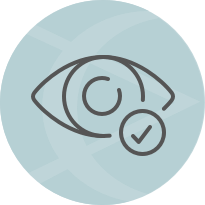Protect Your Vision from Eye Disease
If signs of an eye disease arise, we can take swift action to help manage and treat it early. Take the first step in protecting the longevity of your vision by scheduling your next comprehensive eye exam today.
Our Promise to You
At Clarity Vision Group, we provide our patients with in-depth eye exams to monitor eye health and detect potential signs of eye disease. Our goal is to help you and your family maintain clear vision throughout life.
Age-Related Macular Degeneration
Age-related macular degeneration (AMD) is a progressive disease which degrades central vision, reducing the ability to perceive objects clearly in our direct line of sight. This occurs because the macula, the part of the retina responsible for our central vision, is directly targeted by the disease.
AMD presents without any pain or observable symptoms and can cause blindness if untreated.
Types of AMD
Dry AMD is the less-severe form of the disease. As your eyes age, you may develop a buildup of small proteins known as drusen. These float around inside the eye, casting shadows on the retina which we perceive as small, wriggling shapes in our normal vision.
Moderate to severe dry AMD involves an increased number or size of drusen, but also damage to the macula itself. This can cause a blurred spot in your central vision which can be anything from mildly irritating to impeding your vision, making everyday tasks more difficult.
Wet AMD occurs when the tender tissue inside the retina weakens and ruptures, spilling blood into the eyeball and potentially scarring the macula. Scarring can severely and permanently affect your vision. Such symptoms can escalate rapidly, so you should book an appointment if you notice any problems with your central vision.
Diagnosis
Diagnosis happens in 2 stages. In the first, we examine your retina and inner eye to look for signs of damage indicative of AMD; afterwards, we assess the quality of your vision to see if your central vision is affected.
Advanced imaging techniques like ocular coherence tomography and fluorescein angiography allow us to physically examine the retina and macula. Weakened blood vessels in the eye are highlighted, and their severity indicates disease progression.
Treatment
Currently, there is no cure for AMD. However, if you have wet AMD there are medical injections and laser treatment available to help prevent further vision loss. You may also benefit from technology designed to help those with low vision manage tasks like reading or watching TV.
Cataracts
A cataract occurs when the natural, clear lens in your eye becomes clouded due to a buildup of protein. The buildup of protein prevents light from properly reaching your retina and blurring your vision. Age or injury is a common cause of cataracts.
Cataracts Exam
During a comprehensive eye exam, we’ll go over your medical history—including your family history and personal health to identify high-risk factors.
We’ll also perform a visual acuity test to measure how well you can see with both your peripheral and central vision, across all distances.
Lastly, using a slit-lamp, the cornea will be fully illuminated and examined under magnification. Any abnormalities on the surface of the eye and around the cataract will be assessed.
Treatment
If cataracts are affecting your vision and compromising your ability to perform daily tasks, cataract surgery is a treatment option to provide you with clear vision once again. Your natural, clouded lens is removed and replaced with an artificial, clear implant.
Cataract surgery can restore the clarity of your vision and once replaced, no new cataracts can form. Talk with your optometrist to see if cataract surgery is right for you.
Conjunctivitis (Pink Eye)
The vast majority of conjunctivitis (also known as pink eye) cases are short-lived, and temporary. However, pink eye can be extremely irritating, necessitating time off work or isolation in severe cases.
Pink eye can be caused by bacterial or viral infection, in which case it will be highly contagious for up to several weeks. Conversely, an allergic reaction can trigger the condition, which is harmless to those around you.
Do not self-diagnose conjunctivitis. Treatments and management advice vary on a case-by-case basis.
Symptoms
The most common sign of conjunctivitis is the reddened, inflamed conjunctiva, the network of skin cells surrounding the eyeball. Others include:
- Constant itching around the eyes
- Tearing
- Discharge from the eye
- Light sensitivity
- Blurred vision
Diagnosis
Your eye doctor can perform an extensive assessment of your conjunctiva and the surrounding area to confirm the diagnosis and the severity of your condition. If there is any unusual discharge from the eye, they may submit this for further testing.
In general, your condition can be classified into 1 of 3 types:
- Bacterial—highly contagious and spread from hand-to-eye contact. Consistent and thorough hand washing can help limit the spread of bacterial conjunctivitis.
- Viral—slightly less common than bacterial (but equally contagious), this form of pink eye piggybacks onto many of the airborne pathogens responsible for spreading common cold or flu viruses.
Allergic—triggered by external allergens, this is non-contagious but tends to present with the same persistent symptoms as the viral or bacterial strains.
Treatment
The good news is that conjunctivitis is a temporary condition which often doesn’t have long-term effects on your ocular health or vision. However, it can occur more than once.
You may benefit from a warm compress or some tear-inducing eye drops to keep the affected area hydrated. For severe bacterial cases, we may prescribe antibiotic eye drops, but this will all be discussed at length following your specific assessment and diagnosis.
Flashes & Floaters
Floaters are generally nothing to worry about. Once you notice them for the first time, you should arrange an appointment and undergo an eye health exam. Your doctor can confirm if there is an underlying condition.
Flashes should always be taken seriously. Since they are not a natural occurrence, but are caused by trauma to the optic nerve, any experience of “seeing stars” should prompt a short-notice appointment. Flashes can indicate conditions as serious as retinal detachment, which causes total and permanent blindness in patients.
What Are Flashes?
When light enters the eye, it is focused by an outer lens and lands on the retina. From here, it’s transferred to the optic nerve, which converts the light into electrical signals interpreted by the brain as whatever we are looking at.
Flashes are caused by disturbances to the optic nerve, such as a blow to the head during a football game, and manifest as patches of light on top of our vision, aka “seeing stars.”
What Are Floaters?
A large part of the inner eye is made up of a gel-like substance called vitreous humor. Over time, this gel evolves into a more-liquid state and small buildups of protein can form, floating around the eye. These interfere with the retina and can disrupt vision.
Glaucoma
Glaucoma is commonly referred to as the silent thief of sight, as it affects your peripheral (outer) vision without any observable symptoms or pain. The only way to spot and diagnose glaucoma early—and maximize the percentage of vision retained—is through a thorough eye exam.
Diagnosis
Intraocular Eye Pressure Test
A key indicator of glaucoma is abnormal intraocular pressure. Your doctor will measure the pressure of your inner eye using a non-contact tonometer (commonly known as the air puff test) or the Goldmann Applinator to determine how much force is needed to flatten your cornea.
Visual Field Exam
Glaucoma attacks peripheral vision. By using a series of coordinated flashing lights and recording your responses to them, it is possible to paint a picture of any deficiencies in your outer vision.
Treatment
Since there is no cure for glaucoma, our recommendations will focus on managing its progression and limiting symptoms. Lowering the intraocular pressure to a normal level has shown to be effective at reducing the rate of peripheral vision loss.
It may be necessary to adjust your day-to-day routine or lifestyle to adapt to the changes in your vision, and we can help you make that transition with as much ease as possible.
Visit Clarity Vision Group Today
Your eyes play a vital role in your everyday life, and we want to help make sure they stay healthy. Protect your eyes from sight-threatening eye diseases by regularly visiting your optometrist. Schedule your next appointment today.
Our Services

Adult & Senior Eye Exams
Our comprehensive adult and senior eye exams give us the opportunity to assess your eye health, test your vision, and protect your eyes from future health problems.

Contact Lens Exams & Evaluations
Before you order your next pair of contacts, it’s important to get a proper contact lens exam and evaluation. Contact lenses aren’t suitable for everyone and an exam can help determine what vision correction solution is right for your eyes.

Children’s Eye Exams
Many eye diseases and conditions start to progress during childhood. Protect your child’s vision and eye health by making sure they see us regularly for an eye exam.

Myopia Management
Does your child have myopia or nearsightedness? With a variety of myopia management techniques and treatments, we can help your child’s vision improve.

Our Location
Visit Us Today
When you visit our practice, every step of your eye care experience will be tailored to you. Visit us today to see the difference we can make in your life.
Where to Park
Our practice is conveniently located at the corner of Peachtree Parkway and South Clement Road. There is parking available directly in front of our office.
Our Address
- 1780 Peachtree Pkwy. Suite 301
- Cumming, GA 30041
Contact Us
- Phone: 770-205-2520
- Fax: 770-456-5994
- Text: 770-205-2520
Our Hours
- Monday: 8:30 AM – 6:00 PM
- Tuesday: 8:30 AM – 6:00 PM
- Wednesday: 8:30 AM – 6:00 PM
- Thursday: 8:30 AM – 6:00 PM
- Friday: 8:30 AM – 6:00 PM
- Saturday: 9:00 AM – 1:00 PM
- Sunday: Closed
Our Google Reviews
Our Brands









